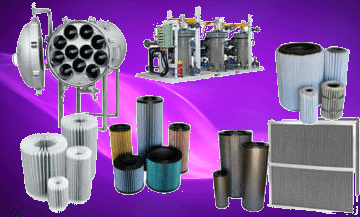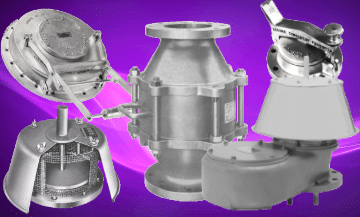What are Breather Valves?
Breather Valves, also known as direct-acting Pressure/Vacuum Valves, are unique kinds of Relief Valves or Tank Vents explicitly designed to protect tanks. The range of products includes vacuum only, the pressure only, and combined Pressure/Vacuum Valves, each with flanged outlets or vented to the atmosphere.
Pressure/Vacuum Relief Valves can be found extensively in bulk storage tanks, including fixed roof tanks, with floating covers, to minimize the loss of evaporation. The Valves help prevent the build-up of high pressure or vacuum that could cause an imbalance in the system or cause damage to vessels for storage.
Springs or pallets with weights control pressure and vacuum levels, and they can be combined to give the needed Pressure and Vacuum settings. It is normal to mix spring and pallet systems as one piece, i.e., the pressure setting requires a section of spring, and vacuum settings rely on using the pallet technique.
How does the breather valve work?
The structure inside the Valve for breathing is composed of an in-breathing device and an out-breathing Valve that can be placed in a row or overlaid. Suppose the tank’s pressure is at a level that is similar to atmospheric pressure. In that case, it is possible that the disc in the pressure valve, the vacuum valve, and the seat function in tandem due to an “adsorption” effect, making the seat impervious to leakage. If the vacuum or pressure increases, the Valve opens and maintains a tight seal due to its “adsorption” effect on the side of the seat.
Suppose the pressure inside the tank rises above the acceptable levels. In that case, the pressure valve is open, and the gas inside the tank is released to the atmosphere outside via the Valve for venting (namely, that Valve for pressure). This is when the vacuum valve closes due to the high pressure within the tank. The out-breathing procedure occurs if the tank has been packed and liquid is vaporized, triggered by a higher atmosphere temperature. The vacuum valve opens because of the atmospheric pressure’s positive pressure. The external gas is introduced into the tank via the suction valve (namely, the vacuum valve). At this point, the Valve shuts. The pressure valve and the vacuum valve are not able to open at any moment. When the vacuum or pressure within the tank is reduced to normal, the vacuum and pressure valves shut and stop the process of inhaling or exhaling.
Most atmospheric tanks require venting equipment to allow large amounts of vapor to escape at external pressures. The typical set pressure is measured in inches of tension in the water column in a vacuum and under favorable conditions. Most big storage tanks are equipped with a slight maximum allowable working pressure.
These tanks are usually large-volume welded vessels constructed according to the API 650 standard. To accommodate large quantities at low pressures, These Valves come with more significant ports than the outlet or the nozzle connection. Low setting requirements require weight loading of the Valve instead of spring loading. In light of this, it is the case that it is necessary to set the Breather Valve will require approximately 100% pressure over set to allow for full openness of the Valve.
Why use Breather Valves
Breather Valves can be described as a safety device mounted in a nozzle opening at the top of an atmospheric storage tank. Its primary function is to guard the tank against rupture or collapse.
Suppose there was no opening or controllable opening. In that case, an atmospheric roof tank may break with increasing pressure resulting from injecting water into the tank or the changes in vapor pressure caused by extreme thermal changes. The implosion or collapse of a tank occurs when the process of pumping out is completed or during thermal changes. As the liquid level drops, the pressure of the vapor space decreases to a level below the atmospheric pressure.
This vacuum condition can be cured with an open and controlled venting system for the tank. In essence, the tank must breathe to reduce the chance of it bursting or collapsing. Due to the primary purpose, it serves, this Valve is referred to as Breather Valve.
Valve selection must be made following American Petroleum Institute Standard API 2000 or any other applicable standard.
How do breather valves function?
The majority of atmospheric tanks require venting equipment that can let large quantities of vapor escape at moderate pressures. The typical set pressure is measured in inches of tension in the water column in a vacuum and under favorable conditions. This is because most huge storage tanks come with a lower maximum allowable working force.
These tanks are usually large volume vessels constructed according to the API 650 standard. To handle large quantities at low pressures, these Valves feature larger ports than the outlet or the nozzle connection. Because of the low setting, it is necessary to weight loading the Valve rather than spring-loading. In light of this, setting the Breather Valve will require approximately 100% pressure over set to allow for whole valve opening.
Breather Valve Working Principe
The breather valve can be described as one kind of Valve for relief. It works precisely, just like the nose functions inside the body. Its primary purpose is to deliver enough air to the tank, even when not breathing. The breather valve can also be called the pressure/vacuum valve (PVRV). It is affixed on the top of a roof-mounted fixed storage tank.
It is available in several varieties, including vacuum only valves, pressure just valves, pipe-away pressure valves, and combined vacuum/pressure type. It shields the storage tank from excessive vacuum and pressure conditions that rupture or implode the tank. They are available with an outlet with a flange and an atmospheric outlet. It can be found in spring, pallet, type, and combined type. The Combine type valve is very sought-after because, in extreme pressure conditions, spring designs can be used, while when the condition is a vacuum, pallet design is shown.
Let’s discuss the need for breather valves. When continuous pumping takes place, tanks need to breathe, which means ensuring the flow of air is required. If the vent isn’t large enough or closed, the tank could explode or break when it occurs. In this instance, if it is found that the pressure is higher than the pressure set by the breather valve, it will open to relieve the pressure. In contrast, when the continuous emptying of the pump is taking place, the tank has to breathe air. The tank may explode when the air vents are shut or are not large enough. The breather valve would be opened and release the vacuum if this happens.
Different types of breather valves
- Breather valve with the only pressure
- Vacuum-only breather valve
- Vacuum breather valve for pressure
Pressure only breather Valve
The pressure-only breather valve is installed in the roof area of the tank storage to handle high pressure. It doesn’t matter if it’s a spring-operated or weighed operated. When the pressure increases, the set threshold of the Valve opens and keeps the pressure constant.
Vacuum-only breather valve
Vacuum-only breather valve is installed on the top of the tank that stores the water. If there is a vacuum and the pressure is lower than set, it will open and keep the pressure through air breath-in.
Vacuum/pressure breather valve
When we combine the above two mechanisms into one device, it becomes a combined vacuum breather valve, and it is based in the same way.
It is also known as an emergency vent valve. The safety vent valve is also a kind of breather valve. When temperatures rise in a sudden fire event or reaction runaway inside the tank, the rate of evaporation rise, and the standard breather valve for pressure isn’t sufficient. In this case, an emergency vent valve, which has an incline of a bit higher, opens and rapidly releases the pressure.
The advantages of breather valves are:
- It reduces the risk of fire.
- Prevent vapor loss (save cost)
- Guards the tank against the risk of explosion and implosion.
- It ensures the safety of pumping operations.
- Low maintenance
How does the breather valve install?
(1) The breather valve must be located at the highest point of the tank’s roof. From the standpoint of reducing losses due to evaporation and other exhausts, it is recommended that the breather valve be located at the highest level of tank space for the most convenient and efficient access to the Valve.
(2) The vast amount of tanks used to stop the use of a single breathing valve because of the danger of failure from negative pressure or overpressure. Pressure, it is possible to install with two breath valves. To prevent two breathing valves’ operation and increase the chance of failure simultaneously generally, two breathing valves suction and discharge pressure in a gradient type design, one of which usually operates, and the other is spare.
(3) If substantial breathing volume makes the volume of breathing for one Valve not to be sufficient and requirements, multiple breathing valves could be fitted as long as the distance they are from the middle of the tank’s top must be equal, i.e., that they are arranged symmetrically on the tank’s top.
(4) In the event that the breathing valve has been mounted within the nitrogen blanketing tank, the position of connection for the nitrogen pipe has to be away from the interface of the breathing valve and placed in the tank at the bottom of the tank, for approximately 200mm, to ensure that the nitrogen doesn’t flow directly into the tank. It also plays the role of blanketing nitrogen.
(5) If there’s an arrestor inside the Valve for breathing, then the effect of the drop in pressure of an arrestor’s pressure on the discharge pressure of the Valve for breathing must be taken into consideration to prevent excessive pressure in the tank.
(6) If the temperature average in the tankless than or greater than the breather valve should be equipped with anti-freezing features to stop the tank’s temperature from freezing and blockage of the valve disc caused by the tank’s insufficient exhaust or lack of air supply that results in an overpressure drum tank, or a low-pressure tank being deflated.
WHY CHOOSE PURPLE ENGINEERING?
We're your friends in the field that genuinely care about our clients projects. We work towards establishing relationships with our clients that lasts for decades not days. That's why we always put our clients' satisfaction first.
We have a wide range of products on offer and hold stock on hand of our critical and high-volume items. This means you can find what you need when you need it.
We have a proven track record of success, and our clients are always happy with the final product. And we're always up for a challenge and love a good puzzle. If you're looking for a reliable, experienced supplier who genuinely cares about your project, look no further than Purple Engineering
YOU DIDN'T FIND THE RIGHT PRODUCT?
Purple Engineering is providing a wide range of Pipeline and Oil & Gas equipment. It is possible that we have the product you are after or know who in the market has it! Please call us and we can confirm if we have the item you are searching for.





